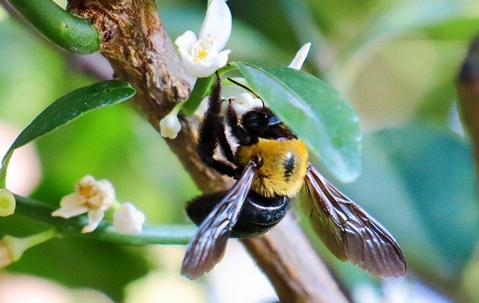Spring is the time for new beginnings and awakenings; it evokes the scent of wildflowers and the buzzing bees that pollinate them. While in the wild, carpenter bees play an important role in the ecosystem as pollinators, but they prove to be a lot of trouble when they get into our houses.
How To Identify Carpenter Bees
There are several hundred species of carpenter bees around the world, with seven species living in the United States. At first glance, carpenter bees may look similar to honeybees. Their bodies are black and shiny, with a peach-fuzz patch of golden hairs on their thorax. They are roughly an inch long and ovular in shape. Unlike their honeybee cousins, carpenter bees do not produce honey. Furthermore, they are not social creatures, preferring instead to build individual nests in wood.
Carpenter bees get their name from their habit of boring holes into wood in order to create their nests and lay their eggs. It is within these nests that carpenter bees hibernate during the winter months to shelter from the cold. Although carpenter bees are found throughout the United States, they do not cause any harm to the health of people. Male carpenter bees cannot sting and females very rarely sting.
What Damages Can Carpenter Bees Cause In Streator?
While carpenter bees cannot inflict physical harm upon people, they can and do cause a lot of property damage and headaches. Streator residents and homeowners should be well informed on the potential damage that carpenter bees cause. Female carpenter bees bore holes into wood to have a safe place to lay their eggs. Inside of these holes, the eggs can safely hatch and mature. Both females and males bore holes to create their galleries, or nests.
These galleries are composed of a series of tunnels for sleeping, mating, and birthing. Carpenter bees will bore into trees, decks, fencing, and siding, and while they do prefer untreated lumber, they have been known to bore into wood that is sealed with paint or stain as well. New galleries tend to be about a half a foot deep, however, carpenter bees reuse older galleries, too, and galleries that have been re-dug can be ten feet deep. The series of holes that carpenter bees dig decrease the structural integrity of the wood, therefore making wooden structures on your property weak. If left unchecked, carpenter bee damage can lead to thousands of dollars in repairs. Furthermore, the larvae hidden within the carpenter bee holes attracts woodpeckers, which further damage property.
Does Anything Instantly Kill Carpenter Bees?
There is no guaranteed way to kill bees instantly on your own. To avoid carpenter bees entering your home, it is a good idea to seal off any access points. Streator residents should ensure that their window and door screens are intact and free of holes so as not to allow carpenter bees in. Doors without screens should not be left open at all. All cracks should be filled in with a silicone-based caulking. Any wooden structure on your property should be sealed with stain or paint to dissuade carpenter bees from burrowing in.
What Is The Best Treatment For Carpenter Bees?
Bees, even carpenter bees, play a very important role in pollinating plants. Thanks to these small insects, thousands of crops, flowering plants, and medicinal plants continue to grow and flourish. As such, it is best to contact a licensed professional, like Quik-Kill Pest Eliminators, to humanely get rid of carpenter bees on your property. We offer fast, effective pest control solutions with guaranteed results. Give Quik-Kill Pest Eliminators a call today and put your mind at ease.

